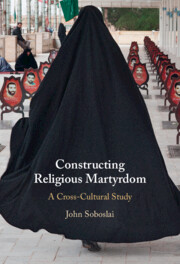Book contents
- Constructing Religious Martyrdom
- Constructing Religious Martyrdom
- Copyright page
- Dedication
- Contents
- Acknowledgments
- Abbreviations of Ancient Sources
- 1 Introduction
- 2 Executed Martyrs in Second-Century Christianity
- 3 The Human Bombs of Twentieth-Century Shi’i Islam
- 4 Sikh Martyr Imaginaries during World War I
- 5 Twenty-First-Century Tibetan Self-Immolators
- 6 Performances of Suffering
- 7 Witnesses to a Sovereign Imaginary
- Epilogue
- Bibliography
- Index
1 - Introduction
Concerning Martyrdom
Published online by Cambridge University Press: 07 June 2024
- Constructing Religious Martyrdom
- Constructing Religious Martyrdom
- Copyright page
- Dedication
- Contents
- Acknowledgments
- Abbreviations of Ancient Sources
- 1 Introduction
- 2 Executed Martyrs in Second-Century Christianity
- 3 The Human Bombs of Twentieth-Century Shi’i Islam
- 4 Sikh Martyr Imaginaries during World War I
- 5 Twenty-First-Century Tibetan Self-Immolators
- 6 Performances of Suffering
- 7 Witnesses to a Sovereign Imaginary
- Epilogue
- Bibliography
- Index
Summary
Chapter 1 outlines the volume’s cases, methods, and arguments. It begins by tracing the linguistic history of the term “martyr” before proceeding to locate martyrdom as an act simultaneously religious and political, personal and collective, and seeking self-actualization rather than self-destruction. In contrast to studies that treat martyrdom as a subset of suicide, I articulate a distinction between self-killing—sanctioned towards certain ends—and self-murder, which is condemned in all religious (and political) traditions. As such, I argue, martyrdom must be approached through a dual window that appreciates both the rationales given by martyrs and their celebration by social groups. I analyze the promise and perils of comparative study towards that end by giving global context to localized crises, and offer a brief reconsideration of the category of sacrifice that will guide my discussion. Finally, I outline the structure of the work and the methodology that uses words written by martyrs in tandem with contemporary accounts and statements by religious and political leaders.
Keywords
- Type
- Chapter
- Information
- Constructing Religious MartyrdomA Cross-Cultural Study, pp. 1 - 63Publisher: Cambridge University PressPrint publication year: 2024

